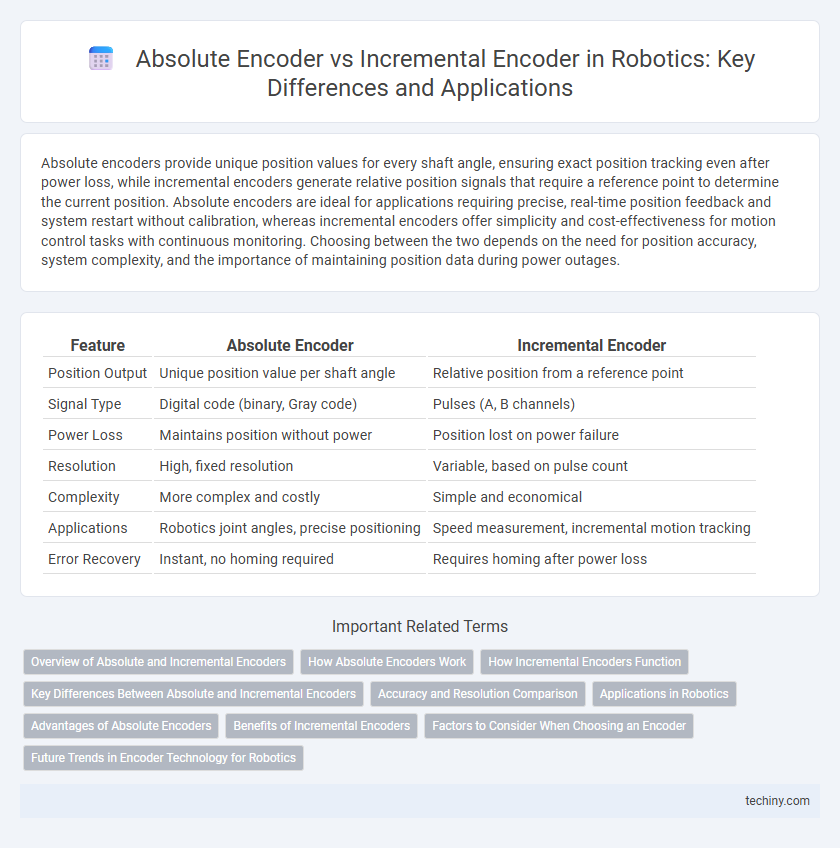Absolute encoders provide unique position values for every shaft angle, ensuring exact position tracking even after power loss, while incremental encoders generate relative position signals that require a reference point to determine the current position. Absolute encoders are ideal for applications requiring precise, real-time position feedback and system restart without calibration, whereas incremental encoders offer simplicity and cost-effectiveness for motion control tasks with continuous monitoring. Choosing between the two depends on the need for position accuracy, system complexity, and the importance of maintaining position data during power outages.
Table of Comparison
| Feature | Absolute Encoder | Incremental Encoder |
|---|---|---|
| Position Output | Unique position value per shaft angle | Relative position from a reference point |
| Signal Type | Digital code (binary, Gray code) | Pulses (A, B channels) |
| Power Loss | Maintains position without power | Position lost on power failure |
| Resolution | High, fixed resolution | Variable, based on pulse count |
| Complexity | More complex and costly | Simple and economical |
| Applications | Robotics joint angles, precise positioning | Speed measurement, incremental motion tracking |
| Error Recovery | Instant, no homing required | Requires homing after power loss |
Overview of Absolute and Incremental Encoders
Absolute encoders provide unique position values for each shaft angle, enabling precise and error-free position tracking even after power loss, making them ideal for robotics applications requiring high accuracy and reliability. Incremental encoders generate pulses relative to motion, offering cost-effective position and speed feedback but needing reference points for absolute positioning, suited for systems where continuous tracking is less critical. Understanding the fundamental differences in feedback mechanisms and data output between absolute and incremental encoders is essential for selecting the appropriate encoder type in robotic control systems.
How Absolute Encoders Work
Absolute encoders generate a unique digital code for each shaft position using a multi-track optical disk or magnetic sensor, enabling precise and permanent position identification. Unlike incremental encoders, which rely on counting pulses from a reference point, absolute encoders output a distinct binary or Gray code directly corresponding to the shaft's angular position. This inherent capability allows robotics systems to maintain accurate position data after power loss or interruptions.
How Incremental Encoders Function
Incremental encoders function by generating pulses corresponding to the relative movement of a rotating shaft, with each pulse representing a fixed increment of angular displacement. These pulses can be counted by an external controller to determine position changes and measure speed, but they do not provide an absolute position reference after power loss. Optical or magnetic sensing technologies are commonly used in incremental encoders to detect shaft motion through patterns on a coded disc.
Key Differences Between Absolute and Incremental Encoders
Absolute encoders provide unique position values for every shaft angle, ensuring precise and instant position detection even after power loss, while incremental encoders generate relative position data by counting pulses from a reference point, requiring a homing sequence upon startup. Absolute encoders are typically used in applications demanding high accuracy and immediate position feedback, such as robotic arm control and CNC machinery, whereas incremental encoders are preferred for speed measurement and simpler motion tracking tasks. The resolution, signal type, and robustness to power interruptions represent critical distinctions influencing the choice between these two encoder technologies in robotics.
Accuracy and Resolution Comparison
Absolute encoders provide precise position data by delivering unique digital codes for each shaft position, enabling high accuracy in robotic applications without loss of position during power loss. Incremental encoders measure relative movement by generating pulses, offering high resolution but requiring a reference point to maintain accuracy, which can lead to cumulative errors over time. The choice between absolute and incremental encoders hinges on the required accuracy and resolution, with absolute encoders excelling in maintaining exact position and incremental encoders providing finer resolution for incremental motion tracking.
Applications in Robotics
Absolute encoders provide precise position feedback critical for robotic arm joint control and automated guided vehicles (AGVs), ensuring accurate path and speed regulation. Incremental encoders excel in applications requiring relative motion tracking, such as conveyor belt speed monitoring and motor shaft rotation measurement in robotics. Selecting the appropriate encoder depends on whether the application demands exact position referencing or incremental motion detection to optimize robotic system performance.
Advantages of Absolute Encoders
Absolute encoders provide precise position feedback by delivering unique codes for each shaft position, ensuring accurate and reliable data even after power loss. They eliminate the need for homing procedures during system startup, reducing downtime and improving efficiency in robotic applications. Their built-in error detection and immunity to electrical noise enhance overall system robustness and performance.
Benefits of Incremental Encoders
Incremental encoders offer benefits such as simpler design and cost-effective implementation compared to absolute encoders. They provide high-resolution feedback for speed and position control, making them ideal for dynamic robotic applications. Their ability to quickly detect changes in position enhances real-time motion control and synchronization in robotic systems.
Factors to Consider When Choosing an Encoder
Selecting between an absolute encoder and an incremental encoder depends on key factors such as positional accuracy, environmental conditions, and system complexity. Absolute encoders offer direct position measurement with unique codes for each shaft angle, ideal for applications requiring precise and non-volatile position data. Incremental encoders provide relative position changes with simpler design and lower cost, suitable for less critical precision needs and environments where power loss reset is acceptable.
Future Trends in Encoder Technology for Robotics
Absolute encoders deliver precise positional data by providing unique codes for each shaft position, enhancing robotic accuracy and reliability, while incremental encoders track movement changes, offering cost-effective solutions. Future trends focus on integrating advanced sensor fusion, miniaturization, and wireless communication to improve encoder performance in harsh robotic environments. Emphasis on AI-driven data processing and edge computing will enable real-time, adaptive motion control in autonomous robotic systems.
Absolute encoder vs Incremental encoder Infographic

 techiny.com
techiny.com